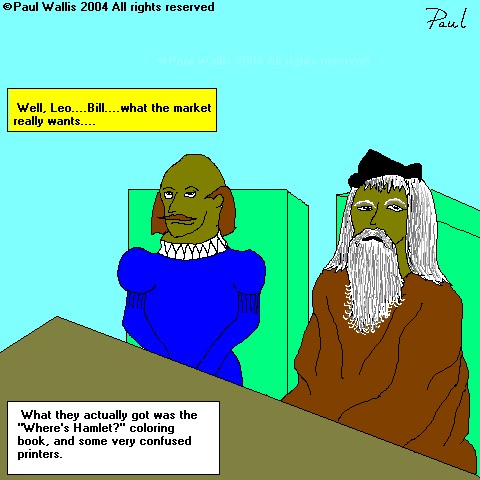Writing for the spoon fed generations of readers

Before recycling old story lines became the only way to communicate with anyone, there was a time when readers weren't so cosseted. They were bodily thrown in to environments like Brave New World, 1984, Ulysses, Wind in the Willows and War of the Worlds. These days, a preamble would be required for a simple storyline beginning.
Great literature can’t develop in a pedant’s paradise of qualifiers, explanations and scene setting:
Imagine Circe from The Odyssey in a modern writing mode. She’d be “an embittered suburban housewife in her late thirties, soured by her failed marriage with a tendency to turn people into pigs.”
Alice in Wonderland would have to have endless notes, and the Mad Hatter’s Tea Party dialogue would need a lot of explaining. Toad of Toad Hall in Wind in the Willows would need to be a “clearly defined character”.
Where did all the truly great books go? People can’t write like that any more, simply because:
(a) They’re not “allowed” to write truly creative work by the market.
(b) People aren’t taught to write creatively, but in forms. You just don’t get Michelangelo’s David out of a Jell-O mold.
(c) The publishers, all from the same photocopier, apparently can’t understand anything which isn’t written in submission format.
(d) Whatever is published has to have some sort of rudimentary market appeal, not, ironically, for the market’s benefit, but so the bureaucrat in the publishing food chain can recommend it.
Unfortunately for readers educated in the last 20 years, exposure to this highly regressive style of commercial writing has severely damaged their ability to read. Education has produced a common denominator in writing, at an extremely low level. The pity of it is that this common denominator has nothing in common with any of literature’s greatest works.
This is a basic One Size Fits All storyline:
Setting and intro. All characters are explained short of actually taking a photo, and providing copies of their birth certificates, qualifications and any relevant police records. Tolstoy managed to define his setting in one sentence at the beginning of War and Peace, but don’t let that stop anyone from using up a few hours of everyone’s lives in the real world of dynamic publishing.
First scene establishes the premise of the storyline and clearly defines every damn thing including the furniture and the view from the garage. This is apparently in case readers contact the publisher and complain that the writer said the window overlooked a valley in the intro, but didn’t mention the valley in the following 400 pages.
Second scene includes the unexpected development in which one or more of the characters is suddenly affected by some disaster. A protagonist or several, presumably out shopping in the first scene, is provided. Now readers, like 5 year old football fans, have someone to barrack for, and can be relied upon to read the next 5 novels to see what happens.
Third scene is a confrontation of sorts, followed by a low point for the main characters. This scene is compulsory and writers who don’t include it will be lectured in infinite detail about how important it is to fabricate unnecessary elements in storylines to maintain reader interests. That’s why Hamlet was such a flop.
Fourth scene is a painstakingly predictable triumph of good over evil, man over circumstances, and clichés over literature. You could pour this slop over any breakfast cereal and all you’d get is conceptual diabetes.
This type of literature is quite harmless. You won’t become a better or more aware person after reading it, and can feel absolutely safe reading it. There’s no chance of anyone having any sort of personal revelation or any other inconvenience. Nothing is difficult to understand, your mind is not challenged in any way, and you can always hide behind the thesaurus if things get tough and polysyllabic.
The alternative form is the sophist form, which doesn’t really need any further qualifiers. It’s exactly the same style written to impress the reader with endless citations of facts to back up assertions. It’s very popular in non-fiction, and has produced some of the worst, most badly researched histories ever written. It also helps support those useful people marketing chalk as a cure for everything.
The real problem is how people are taught. The default method is “learn this”, followed by “regurgitate this”. It’s about as educational as a dating agency ad. Literacy would only get in the way. In 1984, which would have been a terrible dating agency ad, the reader is forced to grapple with an unfamiliar society and its concepts. In Brave New World, the reader is battered by social contexts which don’t even provide the courtesy of an explanation. People are bred in vats, take it or leave it, and to follow the story, you have to understand that.
You can’t “learn and regurgitate” this sort of material. It requires extrapolation and some form of understanding of multiple contexts. This sort of literature has therefore dropped off the radar. The market approach is now the benchmark for what is publish-able.
Imagine writing a modern style submission for Catch 22, for instance, according to submission guidelines:
“Give a brief synopsis of the story…” That’s doable, mainly because you can write anything as a synopsis, but would it have anything to do with what’s so great about the book?
It couldn’t. Nor could this procedure be usefully applied to any of the other great literary works, for the same reason. Romeo and Juliet can be called a love story, but does that actually explain a damn thing about the storyline?
I’m constantly amused by the reaction to my own books. The usual response is “I like it, but I don’t think anyone else would get it.” That may have something to do with my own view of writing. I refuse to write in the market style. Readers get thrown in to situations in which they may simply have to put up with a musician looking for an escaped symphony, a child running a planet, or generations of people living under expensive wallpaper. Another character is an intelligent stock cube, who’s the senior administrator of an organization called the Scientocracy, and there’s a woman who’s so beautiful she kills people. One book is devoted to the search for Ultimate Comfort.
In my first book, I went looking for the most implausible possible reason for stealing humanity. Did anyone want to save the world? Not really, and they had some pretty good reasons for not wanting to do it. My characters are never even described, physically, to the point anyone would be able to form a clear picture of what they look like. One of them is ash blond, and I didn’t say which one. In one of the stories, a rabbit explains to British police how not to be omniscient using the word Vothsnathwuthsnuthfruthswabbledroneyflads. Ghastly, isn't it?
Very inconsiderate of me, I know, but that’s how I feel about market-style literature. The “communicate at the lowest common denominator level” form of writing is what it is. The trouble is that it can’t be anything but what it is.
I never expect to be published by mainstream publishers, unless they suddenly develop an urge to warn writers not to write like me.
I can live with that.
In fact, I could think of no greater compliment.
Just don’t ask me to write like that. I do regret that people taught to read shopping list style writing may never be able to read my stuff, because I have so much fun writing it. I won't be changing that style. Call it surreal, call it whatever, but at some point a writer needs to be honest.







